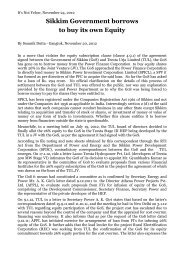Socio-Cultural Environment - Affected Citizens of Teesta (ACT)
Socio-Cultural Environment - Affected Citizens of Teesta (ACT)
Socio-Cultural Environment - Affected Citizens of Teesta (ACT)
You also want an ePaper? Increase the reach of your titles
YUMPU automatically turns print PDFs into web optimized ePapers that Google loves.
In the South district, the majority <strong>of</strong> the people are <strong>of</strong> Nepalese<br />
origin. During the initial period <strong>of</strong> their migration to this area, all the<br />
Nepalese were bracketed as ‘Paharia’ by the Lepcha-Bhutias. The so-<br />
called Paharias, during the course <strong>of</strong> their adaptation to their new home,<br />
adopted many a social norms set by the Sikkim rulers. As a result, the<br />
behaviour <strong>of</strong> the Nepalese community residing in Sikkim acquired some<br />
distinctiveness in contrast to their brethren in mainland Nepal. For<br />
example, in spite <strong>of</strong> their affiliation to Hinduism, many <strong>of</strong> them perform<br />
Buddhist rituals, which is not so common in Nepal. On the other hand,<br />
the Bhutias who take great pride in their ancestry and heritage have<br />
accepted the language <strong>of</strong> the Nepalese as the means <strong>of</strong> communication.<br />
The Lepchas and the Limbus are less rigid and have free exchanges<br />
with the Nepalese.<br />
3.5 CONFLICTING INTERESTS<br />
In South Sikkim, the conflicting interests are not very apparent<br />
since the majority <strong>of</strong> the inhabitants are Nepalese. Though the Nepalese<br />
form the largest ethnic group in the district, they do not necessarily act<br />
as a homogenous group, especially in matters related to state politics. In<br />
recent years, some <strong>of</strong> the ethnic Nepalese are demanding their separate<br />
identity, distinct from the others, and are eschewing the habits and<br />
cultures they acquired from other, more powerful races over decades, if<br />
not centuries <strong>of</strong> co-existence. The Kirati communities, such as the<br />
Gurungs, Rais and Subbas are reverting back to their roots, customs<br />
and culture. There are definite signs <strong>of</strong> tribal revivalism against the<br />
dominance <strong>of</strong> Hinduism and Lamaism.<br />
28<br />
CISMHE




